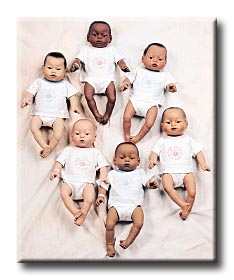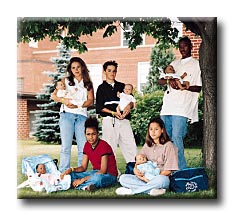Have a Baby?
I Think I'll Think It Over
(Any time you see a link, you can click it for more information
on that word or topic)
What's it all about?
The Baby Think It Over infant simulator is a lifelike, life-size baby
doll with realistic computerized responses, which allows teens to experience
some of the demands of infant care.
It is being used by schools and other organizations to help adolescents
appreciate the responsibilities involved with parenthood.
After spending a couple of days and nights with the Baby Think It Over
infant simulator, many teens come to realize that they are not yet ready
to take on the pressures and responsibilities of parenting.
What's the problem?
Helping young people avoid unwanted pregnancies and sexually transmissible
infections is a challenge that faces communities around the world.
Children having children is a problem with dire consequences for both
young people themselves and for society as a whole. Young people with
children often have sharply reduced education and employment opportunities
and a poorer quality of life. Meeting their needs places a severe burden
on both families and public resources.
Moreover, sexually active teens are at great risk of contracting AIDS
and other sexually transmitted diseases.
The United States has the highest rate of teen pregnancy of any industrialized
nation -- twice as high as England, France and Canada, and nine times
as high as the Netherlands and Japan.
More than one million teenage girls become pregnant each year in the
U.S. -- 11% of all women aged 15-19 -- with over 40% of all females under
20 having at least one pregnancy. Over three fourths of teen pregnancies
are unplanned, accounting for about one fourth of all accidental pregnancies
each year. About 55% of teen pregnancies end in birth, 31% in abortion,
and 14% in miscarriages. Of those teenage women who choose to become mothers,
one out of four will have a second child within two years of their first.
Young people also have a high incidence of sexually transmissible infections.
More than 25% of sexually active adolescents in the U.S.-- over three
million teens -- acquire a sexually transmitted disease each year, threatening
their ability to have children and increasing their risk of cancer and
infection with the HIV/AIDS virus. In a single act of unprotected sex
with an infected partner, a teenage woman has a 1% risk of acquiring HIV,
a 30% risk of getting genital herpes, and a 50% chance of contracting
gonorrhea. While the risk of acquiring HIV is lower than that for other
sexually transmissible infections, AIDS is the sixth leading cause of
death among 14 to 25 year-olds, and the leading cause of death among 25
to 44 year-olds, in the U.S. today.
What is it, and how does it work?
The Baby Think It Over infant simulator was born in 1993, the brainchild
of Richard Jurmain, an aerospace engineer in southern California who had
lost his job and was looking for a way to feed his family. He got the
idea for Baby after watching a public television program on sex education
for teenagers. Young women in the program carried bags of flour to simulate
babies, but bags of flour, as he noted to his wife, do not wake people
at night. "So make one that does," she replied, and he did.
Once Mr. Jurmain obtained a patent on Baby, he made 40 himself, working
in his garage. When orders started to accumulate, he contracted with an
organization that uses physically handicapped workers to make the infant
simulators. He maintains that the main lessons learned from Baby are not
about values but "sleeplessness". And sleeplessness, he observes, "is
a compelling rationale for not getting pregnant."
 The
infant simulator is a lifelike, life-size (20 1/2 inches) vinyl baby weighing
6.5 pounds. It is anatomically correct and available in both sexes and
five different ethnicities. An internal computer simulates an infant crying
at realistic, random intervals 24 hours a day. Intervals can be adjusted
from 15 minutes to 6 hours for a normal, cranky, or particularly easy
to care for baby. The
infant simulator is a lifelike, life-size (20 1/2 inches) vinyl baby weighing
6.5 pounds. It is anatomically correct and available in both sexes and
five different ethnicities. An internal computer simulates an infant crying
at realistic, random intervals 24 hours a day. Intervals can be adjusted
from 15 minutes to 6 hours for a normal, cranky, or particularly easy
to care for baby.
The "parent" is given a non-transferable key attached to a hospital
bracelet on his or her wrist that must be inserted in the Baby for a specific
length of time to simulate feeding, bathing, diaper-changing and comforting.
Care sessions last from 5 to 35 minutes. If the "baby" has been properly
cared for, it will coo to signal the end of the session. If it is neglected
(allowed to cry for more than one minute) or handled roughly (dropped,
thrown or struck), tamper-proof indicators on the computer will alert
the instructor. A drug-affected model, smaller in size, has the additional
feature of simulating tremors due to withdrawal from a mother's drug addiction
during pregnancy.
When Jaime Mercado, principal of Palomar High School in Chula Vista,
California saw a newspaper article about the Baby Think It Over infant
simulator, he decided he had to try it. First he tried it on his own daughter
and then in his school, which has a large percentage of "continuation"
(or "problem") students who are vulnerable, needy, and at high risk of
pregnancy and sexually transmissible infections. Because of the school's
"continuation" status and relatively small size with only 450 students,
Mr. Mercado feels that he has more flexibility than he would in a mainstream
school.
 Since
1994, caring for the Baby Think It Over infant simulator has been a classroom
assignment for the 10th grade "Social Living" course at Palomar High and
a requirement for graduation. Students may take Baby home overnight or
on a weekend and are required to keep a journal. Student reaction to the
infant simulator has been very encouraging. "I don't want babies; I'm
gonna wait," is a fairly typical response of those who have experienced
caring for Baby. Mr. Mercado sees the infant simulator as a good teaching
tool, "better than an egg or a sack of flour." Since
1994, caring for the Baby Think It Over infant simulator has been a classroom
assignment for the 10th grade "Social Living" course at Palomar High and
a requirement for graduation. Students may take Baby home overnight or
on a weekend and are required to keep a journal. Student reaction to the
infant simulator has been very encouraging. "I don't want babies; I'm
gonna wait," is a fairly typical response of those who have experienced
caring for Baby. Mr. Mercado sees the infant simulator as a good teaching
tool, "better than an egg or a sack of flour."
Does it actually work?
More than one million teens have used Baby Think It Over since its creation
in 1993. As of 1998, over 40,000 infant simulators have been sold in the
United States, Canada, United Kingdom and Australia. Recent studies have
shown that the use of Baby Think It Over is more effective in changing
the attitudes of adolescents toward parenting than other popular strategies
such as shadowing a teen parent for a day. Reductions of up to 50% in
the rate of teen pregnancy have been reported by some schools and teachers
who have used the infant simulator. Baby Think It Over has received several
major awards, including the What's New in Home Economics "Healthy Living
Award" for 1995, 1996 and 1997; the Parenting Magazine "Parenting Achievement
Award" for 1995; and the Fortune Magazine "Product of the Year Award"
for 1994.
|













